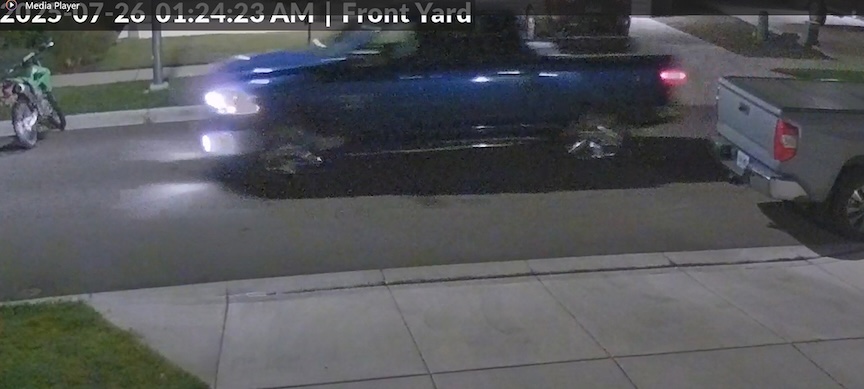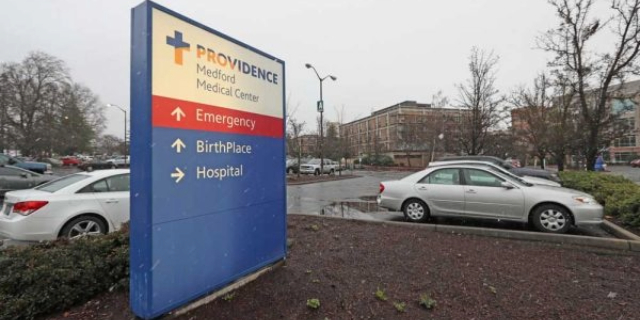Ashland residents urged to prepare for approaching wildfire season
Published 10:05 am Saturday, May 3, 2025

- The Almeda Fire burns through the night in 2020. Ashland.news photo
Making sure your property and you are ready for a catastrophic fire event can make a world of difference
The Almeda Fire was an example of a troubling trend: not wildfires, but urban firestorms caused by wildfires, said Brian Hendrix, Ashland Fire & Rescue’s Fire Adapted Communities coordinator.
Hendrix was one of several Ashland city staff and volunteers sharing a variety of ways people can protect themselves and their neighbors from wildfire and be prepared to evacuate at the first of several wildfire preparation events, scheduled from spring to deep into fire season.
Trending
Embers can be blown by wind miles ahead of the fire and can ignite on whatever they land on. A larger bush can burn at around 500 to 600 degrees, while a home can burn at thousands of degrees and a standard window can only withstand around 180 degrees, Hendrix shared.
“Every single home in our community matters because to protect one home, we have to protect them all,” he said.
Fire free zones
Hendrix stressed creating a “fire free zone” — a five-foot buffer encircling a home. He added to make that buffer 10 feet for homes with risks such as wooden siding, a wooden deck or wooden fencing nearby. In the current economy, many may not have the financial means to replace these fire prone materials, but Hendrix encouraged focusing on what can be done.
The fire-free zone should be rock, bare dirt or mineral soil. Bark mulch and other debris should be at least five to ten feet from a structure. Even leaves against the base of a building in a backyard could catch an ember and let fire in through small gaps in siding.
Vegetation should be thoughtfully chosen — the city offers best practices for fire resistant landscaping — and plants should be trimmed and routinely cleared of debris that can become trapped in shrubs, bushes and fast growing vines such as ivy. Large evergreen shrubs and trees can hold dead plant matter and debris inside them. This, combined with their natural oils, make them highly flammable.
Trending
Bushes, shrubs, trees or bamboo used for privacy screening between homes can make two homes susceptible to fire simultaneously. Neighbors should have open, friendly and supportive conversations to help each other harden their homes. Plants should be spaced out with paver stones or rocks between them.
“That way, it’s not just one continual horizontal fuel that could all burn over time close to a structure,” Hendrix said.
Additional checks
Fire free zones aren’t the end of the inspection. The structure itself needs it, too.
Old or damaged wood should be replaced and repaired, along with cracks or gaps in home siding. Vents and attic spaces should be checked at least once a year to be sure no critters have damaged them and created a gap for embers to sneak through.
It’s easy to forget about the fire risk of outdoor accessories or items commonly left on patios and in sheds such as containers of flammable gases, fuel, wood piles or other flammable materials, Hendrix said. Gutters should be cleared regularly and, if possible, covered with screens. Roofs need to be cleared of moss, which can dry out and become fire fuel while also creating gaps between roof shingles for embers to sneak through.
“You might be getting a theme here. It’s: maintenance, maintenance, maintenance,” Hendrix said.
Where there’s smoke
After the property is secure, residents have to protect their health from fire, too.
During fire season, residents face three factors from smoke itself: level, time of exposure, and activities that may alter breathing rate, said Sara Jones, Community Engagement Coordinator for the Ashland Forest Resiliency.
Jones advised purchasing air filters before smoke, as filters and supplies run out quickly. It’s also important to have proper respirators — a properly-fitted NIOSH approved N95 or P100 face mask, she said.
During a smoke event, residents should stay hydrated and modify life to stay indoors such as working out inside in lieu of going on a trail run or hike. Anyone who must go outside should properly put on a respirator, check for any damaged or broken pieces on it, and replace it as needed.
“Don’t use that respirator to go on a two-hour walk; use that respirator to go on a shorter walk,” Jones said.
During a smoke event, Jones advised using fire.airnow.gov and the Airnow app to monitor air quality
“Smoke is here to stay. I think what’s important to remember is that we are here to stay, too,” she said.
Packed up
Area residents should also be ready to flee at a moment’s notice with essentials in tow.
A few items, carefully chosen and packed into plastic tote, can make an effective “go bag,” and keep a family safe and a little more comfortable during an evacuation, said Mike Connelly, a volunteer of five years with the city’s Emergency Response Team.
A good “go kit” should have minimal but carefully chosen supplies — glasses or contact lenses, seasonal clothing for two to three days, disinfectant and hygiene wipes, medications or medical devices, a cell phone and a charger. Important documents such as banking or medical information and insurance policies, identification cards or a passport should be included.
Connelly also recommended a portable radio, cash and credit or debit cards, paper maps, a first aid kit, flashlights, books or playing cards to pass the time, and shelf stable foods — foods that can be stored at room temperature — such as protein bars, peanut butter, dry cereal or canned food. He recommended having at least one gallon of water per person per day, and to ensure bedding, carriers, medication and food are ready for pets.
Communication is key
While the government response – city, state and federal — to the Almeda Fire was “kind of clunky,” the grassroots response from residents was impressive and made the difference, Emergency Management Coordinator Kelly Burns said.
In his role, Burns has seen state and local governments improve their efforts at communication and helping residents become more prepared. The Rogue Valley has, for the first time, developed interconnected disaster messaging and is reaching Spanish speakers, leading to yet another name change for alerts — Jackson Alerts. Burns urged the audience to focus on ensuring they are signed up for alerts.
Evacuation notices — in levels of 1, 2 and 3 — will come in with information to help residents respond. That said, level 3 evacuation notices may come with “some nuance.” In certain extreme situations, a knock on a door from law enforcement is considered a level 3, regardless of whether an evacuation message has been sent.
“If one of these people tells you, ‘You should get out,’ you should believe them,” Burns said.
Residents should memorize the city’s evacuation zones and explore local roads to prepare primary and secondary evacuation routes in case of road blockages. Checking weather reports can be another way to stay safe, and wind patterns can help in preparing to evacuate, as the valley winds move from Ashland to Medford in the morning and change directions in the afternoon.
While this is not a perfect science, “The fire is going to follow that,” Burns said.
In the event of another major wildfire, Burns reminded event attendees that they will need each other and to be prepared themselves.
“During an event like Almeda, there may not be enough emergency responders to help evacuate your home. There won’t be enough,” he said.
Fire and Life Safety Specialist Sydney Jenkins reminded the crowd the deadline to trim weeds and grasses is June 1, and that the city of Ashland enforces weed abatement during fire season. Those who are concerned about a property in Ashland can report it using the city’s See Click Fix feature.
Additional resources
The workshop was the first in a series held jointly by the city of Ashland, with partners including Ashland.news and Ashland Climate Collaborative.
A recording of the full workshop is available online, and an additional open house to meet members of Ashland Fire & Rescue and help the city create an updated Community Wildfire Protection Plan will be held 2 to 4 p.m. Sunday, May 4 at the Grove, 1195 E Main St. A full calendar of wildfire preparation events is also available on the city website.
Resources to obtain a wildfire risk assessment and learn about weed abatement are also available online, Additionally, Smokewise Ashland also has a website with resources and information about events. Jackson County also provides online resources to help residents prepare for wildfire.
To learn about joining Ashland’s CERT team and assisting in disaster preparation and response, visit the city’s website.
Email Ashland.news reporter Morgan Rothborne at morganr@ashland.news. This story first appeared at Ashland.news.








